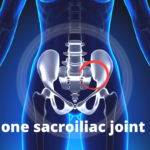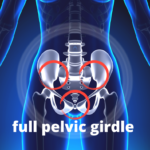Pelvic and Low Back Pain with Pregnancy

It is estimated that 50% (1) of women will develop pelvic and or low back pain with pregnancy. A typical presentation is pelvic girdle pain (sacroiliac joints or pubic symphysis) which changes to low back pain after delivery.
Many sources have cited the cause of pelvic and low back pain with pregnancy is the hormone relaxin. The purpose of relaxin is believed to cause a looseness of the ligaments of the pelvis, allowing it to expand as the baby passes through the birth canal. It has been theorized that this looseness leads to pelvic and low back pain with pregnancy. However, research shows that there is no direct correlation with the level of relaxin in the bloodstream and the pain reported by women during pregnancy. (2) How relaxin may be related is the laxity it produces may be to exacerbating already existing mechanical problems that were not causing symptoms.
Evaluating women with pelvic and low back pain with pregnancy begins with noting the location of the pain, as this can be a significant indicator for treatment success or prolonged till after birth. Five patterns of pelvic pain are recognized (1):
- 1. In the front, only at the symphysis pubis (best prognosis)
- 2. In the back of the pelvis, involving pain over both sacroiliac joints
- 3. In the back of the pelvis involving pain over one sacroiliac joint
- 4. The full pelvic girdle: pain in front at the pubic symphysis and in the back, both sacroiliac joints.
- 5. Miscellaneous – whereby pain location varies constantly between the 3 locations




Regarding the prognosis of successful treatment, pain only in the pubic symphysis has the best prognosis and full pelvic girdle pain is the most difficult, typically lasting past delivery.
When considering the source of pelvic and low back pain with pregnancy, there are 3 changes with pregnancy that should be evaluated:
Ligament laxity
As mentioned earlier, with the release of the hormone relaxin, underlying mechanical instabilities can become worse. One such condition can be the weakness of the sacroiliac joint locking into place to transfer the forces placed on it from standing or walking this complex mechanism is also known as form and force closure. Many women can have a weakness of the muscles in the buttocks prior to becoming pregnant, yet minimal symptoms. With the laxity of the ligaments, this muscular weakness becomes more obvious as the SI joint cannot be locked into place while walking or standing.
Increased low back curve
Hyperlordosis or increased low back curve is noted in most women during pregnancy. It has been shown that a 20% increase in weight can increase the pressure on the joints of the low back by 100%. Any preexisting problems can be aggravated by the increased pressure.
Soft tissue swelling
As most women who have been pregnant can attest; the body starts to swell. In fact, 80% of pregnant women experience some type of soft tissue edema. The most typical time is in the last 8 weeks of pregnancy. Fluid retention increases the chances of nerve entrapments, such as carpal tunnel syndrome as swell as swelling in the calf and cramping.
The Good News
The good news is that in many cases of pelvic and low back pain with pregnancy, comprehensive chiropractic management can be successful and providing relief. A combination of safe, gentle manipulations to the pelvis, exercises and lifestyle changes are the most successful conservative approach.
Dr. Schmaltz has years of treating women with pelvic and low back pain during their pregnancies. He uses specific methods that are low force, gentle and safe for both mother and the baby. Call our office today at (314) 731-4383 to schedule an examination.
